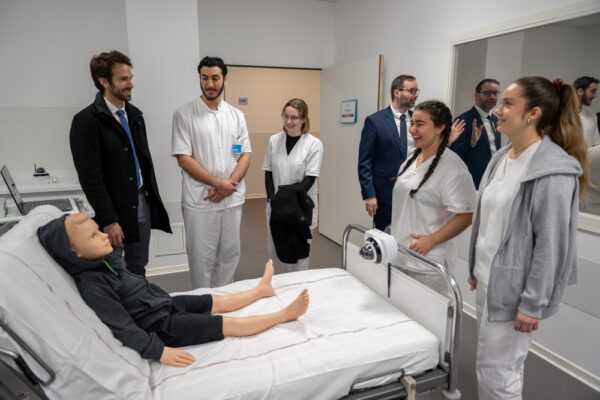This content was reviewed by Stephen Garber, MD, Anesthesiologist in Southern California.
Ultrasound has fundamentally changed how clinicians approach neuraxial anesthesia. For years, palpation has remained the primary technique for identifying neuraxial landmarks. But as studies consistently show better first-pass success rates and fewer complications with ultrasound guidance, more providers are turning to this imaging modality.
The issue? Many anesthesia training programs continue to lack structured curricula focused on neuraxial ultrasound, though protocols are emerging to address this need. The result is a growing gap between what technology can offer and what clinicians are equipped to deliver. Ultrasound training is valuable — now more than ever. It’s time to address barriers to widespread adoption and ensure education and collaboration can catch up to the needs of modern anesthesiology.
Ultrasound training matters now
Patient anatomies are changing — and fast. Rising obesity rates, aging populations, spinal deformities, and a growing volume of patients with prior spinal surgeries have made blind palpation more difficult and less reliable.
Ultrasound-assisted neuraxial anesthesia provides a promising solution. By visualizing key landmarks and improving accuracy, providers can reduce the risk of dural punctures, failed epidurals, paresthesia, and other complications. However, the precision promised by ultrasound depends on clinician skill with the imaging tool itself.
Interpreting neuraxial ultrasound images requires more than passing familiarity — it demands the ability to acquire high-quality images, recognize anatomical variations, and adapt procedural plans accordingly. In other words, access to technology alone is not enough. Without formal training, the benefits of ultrasound cannot be consistently delivered to patients.
In many institutions, peripheral regional anesthesia has already adopted ultrasound guidance as a standard of care, and educational programs have been assembled in response. With accumulating clinical evidence, neuraxial anesthesia is likely to be next. Institutions that fail to prioritize ultrasound training may encounter increased clinical challenges and legal liabilities associated with avoidable procedural complications such as post-dural puncture headaches.

Current gaps and challenges in training
While ultrasound-guided neuraxial anesthesia holds the promise of safer, more precise procedures, clinical training remains fragmented and underdeveloped. Despite years of documented benefit, most anesthesiology residency and fellowship programs still rely on informal, inconsistent approaches to ultrasound education. The prevailing model — shadowing experienced providers and learning through trial and error — yields variable results and leaves too much to chance in a high-stakes clinical domain.
Informal learning undermines standardization.
Without formalized curricula, ultrasound skills are often acquired inconsistently. One resident might gain ample hands-on experience under an engaged mentor, while another may graduate with only cursory exposure. This variability is inefficient and clinically risky. When training lacks structure, proficiency is subjective, and competency becomes a matter of confidence rather than standardized, demonstrable skill.
Competency without consensus causes fragmentation.
The absence of shared benchmarks for what constitutes “ultrasound competency” further erodes training consistency, particularly in neuraxial anesthesia procedures where techniques and methods are often highly nuanced. Credentialing becomes difficult without validated metrics for image acquisition, anatomical identification, and real-time decision-making. And without accountability frameworks, institutions cannot ensure that new technologies translate into improved outcomes. Initiatives like the ASRA-ESRA Delphi Consensus Study are working to standardize terminology and procedural definitions, which can serve as a foundation for aligned training metrics and competency benchmarks across institutions.
Educational models aren’t built for cognitive diversity.
The logistical realities of residency training add another layer of complexity. Residents juggle high clinical loads with limited time for skills development. Add to that the cognitive diversity of adult learners; some thrive on visual repetition, while others require kinesthetic reinforcement. One-size-fits-all workshops or online modules fall short. Current programs rarely offer the flexibility or personalization needed to truly build proficiency across a cohort.
Technology outpaces training.
AI-enhanced, handheld ultrasound tools like Accuro Neuraxial Guidance offer promising efficiencies to anatomic recognition and preprocedural guidance, including a demonstrated 81% increase in first pass success compared with palpation. But these platforms must be integrated intentionally into a broader educational framework that teaches not just how to use them, but when to trust them and how they influence outcomes in complex cases. Otherwise, even intuitive devices risk being underutilized or misapplied.
Closing the training gap is not merely about inserting ultrasound modules into existing curricula. It requires a shift toward competency-based education that is adaptable, inclusive, and rigorously evaluated. Simulation, assessment protocols, and layered mentorship need to be embedded across the training continuum. And as devices grow more intelligent, educational models must mature in parallel to ensure those advancements actually enhance care, rather than obscure responsibility.
Ultrasound’s potential to transform neuraxial anesthesia won’t be realized through better technology alone. It demands a parallel revolution in how we teach, assess, and support clinicians from training to practice.
Technology-enabled training in academic medical centers
The Accuro 3S platform, a next-generation ultrasound system currently in development by RIVANNA, is designed with enhanced bony landmark visualization and real-time needle-tracking capabilities. Accuro 3S’s TeachAssist feature, paired with dynamic imaging capabilities that highlight spinal anatomy in real time, may enable supervising physicians to observe and guide procedures more effectively.
In academic medical centers, where attendings oversee residents during epidural placement, this type of shared visual reference can strengthen both safety and skill development. Instead of relying solely on verbal instruction or post-procedure debriefs, faculty can intervene mid-procedure using live anatomical context, making feedback more immediate and actionable.
As ultrasound guidance becomes increasingly integral to neuraxial anesthesia, technologies that support dual-purpose use, both care delivery and competency building, may prove critical in closing the training gap at scale.

Building effective training pathways
If ultrasound guidance is the future of neuraxial anesthesia, then the current training paradigm must evolve. Traditional apprenticeship models, while valuable for hands-on learning, are no longer sufficient in preparing clinicians for the cognitive and technical demands of ultrasound-guided techniques.
What’s needed is not just exposure, but structured, iterative learning that makes sonographic proficiency a baseline. The good news? The scaffolding for this transformation already exists.
- High-fidelity simulation: High-fidelity simulation creates a controlled environment for deep pattern recognition and procedural fluency. Unlike traditional models that depend on opportunistic learning in high-stakes settings, simulation offers repeatable practice in scanning, interpreting anatomy, and aligning the needle in real time without jeopardizing patient safety. The result is accelerated skills acquisition and a foundation for objective, performance-based assessment.
- Real-time mentorship: Hands-on feedback from experienced mentors during clinical rotations can dramatically speed up the learning curve. Incorporating ultrasound interpretation into daily workflows makes skill development a natural extension of patient care rather than an isolated learning module.
- Cross-disciplinary collaboration: Anesthesiologists are experts in physiology, but sonographic anatomy demands a distinct visual literacy. Collaborating with radiologists and sonographers brings precision to pattern recognition and sharpens anatomical fluency. This kind of interdisciplinary dialogue challenges assumptions and introduces new scanning techniques or probe orientations that might not otherwise surface uniformly.
- Remote and VR training platforms: New educational models are expanding access to ultrasound training worldwide. Virtual reality (VR) simulations, tele-mentoring, and online ultrasound courses allow providers in rural, resource-limited, or otherwise isolated settings to build skills without waiting for in-person opportunities.
- Institutional investment: No training overhaul succeeds without buy-in from the top. Institutional investment — financial, cultural, and logistical — is the enabling force behind meaningful change. That means funding simulation labs, incentivizing faculty development, updating competency metrics, and integrating ultrasound training into residency milestones and recertification pathways. The infrastructure must match the ambition.
Preparing the next generation of anesthesia providers for an ultrasound-guided future is not a matter of individual initiative — it’s a systems-level mandate. The technology is ready. The urgency is real. What remains is aligning education models, mentorship, and policy to ensure readiness isn’t the exception but the standard.

Moving from acknowledgment to action
Thinking of ultrasound as an emerging trend in neuraxial anesthesia could leave providers and hospitals behind the curve. This technology might soon become a necessary tool in the modern provider’s skillset. Without intentional education, mentorship, and institutional support, the promise of ultrasound guidance cannot be fully realized.
As clinical complexity rises and expectations for image-guided procedures increase, ultrasound training must become a core component of anesthesiology education. The next generation of clinicians will need more than informal instruction and limited access. They’ll need structure, rigor, and support to provide the care patients expect and deserve.
Let’s move from acknowledgment to action. By investing in thoughtful, standardized training models today, we can ensure safer, more effective, and more equitable anesthesia care tomorrow.
